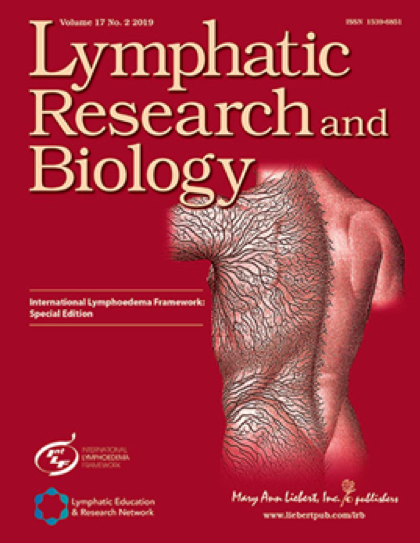Hot of the Press May 2019 – Special Edition


International Lymphoedema Framework
Final results of ILF’s large, international LIMPRINT study have provided new data on the prevalence of chronic swelling and the devastating impact it can have on health-related quality of life.
In a special issue of Lymphatic Research and Biology, the results are presented through a broad range of articles that give a comprehensive view of the conceptual design, implementation, results, and interpretation of the LIMPRINT study.
Chronic edema caused by the relative failure of the lymphatic system is mistakenly thought of as a rare condition, when, in fact, it is not only a relatively common, universal medical problem, but also very difficult to treat.
Insufficient data have not been available to estimate the size of the affected population and, thus, to support the extensive impact of this disease. In response to this need, the ILF coordinated and completed the Lymphedema Impact and Prevalence project (LIMPRINT) on a worldwide scale.
The Concept of Chronic Edema – A Neglected Public Health Issue and an International Response: The LIMPRINT Study
Christine Moffatt, Vaughan Keeley, and Isabelle Quéré, Lymphatic Research And Biology , Volume 17, Number 2, 2019
The authors describe LIMPRINT, the difference between lymphedema and chronic edema and how the definitions of these conditions are changing, and they explore the complex patient profiles and new understanding of the underlying physiology. They also provide an overview and comparison of recent epidemiology studies.
The Development and Validation of the LIMPRINT Methodology
Christine Moffatt, Peter Franks, Vaughan Keeley, Susie Murray, Gregoire Mercier, and Isabelle Quéré. Lymphatic Research And Biology Volume 17, Number 2, 2019
This article describes the methods adopted in the development and validation of the LIMPRINT study.
LIMPRINT The acronym LIMPRINT stands for Lymphedema IMpact and PRevalence- INTernational Lymphedema Framework and presents the aim of the study, which is ‘‘To determine the impact and prevalence of chronic edema within health services at a national and international level using a common methodology.’’
LIMPRINT was a two-phased project. Phase 1 was conducted between June 2013 and June 2014 with the development and validation of the methods within two large pilot projects. Phase II involved roll out across all sites (9 countries and 40 sites) from June 2014 until August 2017.
LIMPRINT: Estimation of the Prevalence of Lymphoedema/Chronic Oedema in Acute Hospital in In-Patients
Isabelle Quéré, Sylvie Palmier, Susan Nøerregaard, Jenica Pastor, Martina Sykorova, Eleanor Dring, Peter J. Franks, Susie Murray, Vaughan Keeley, Susan Bermark, Tonny Karlsmark, Norah Kyne, Mary-Paula Colgan, Marie-Michelle Coulombe, Sandrine Mestre, Gregoire Mercier, and Christine J. Moffatt. Lymphatic Research and Biology, Volume 17, Number 2, 2019 Pages:135–140
This paper discusses the prevalence of lymphedema/chronic edema (CO) and wounds in acute hospital inpatients in five different countries. The authors conclude Lymphedema/CO is very frequent in patients hospitalized in hospital acute wards. It is strongly associated with obesity, venous insufficiency, and heart failure. Their results strongly suggest a hidden health care burden and cost linked to CO independently of chronic wounds.
LIMPRINT in Specialist Lymphedema Services in United Kingdom, France, Italy, and Turkey
Vaughan Keeley, Peter Franks, Isabelle Quéré, Gregoire Mercier, Sandro Michelini, Marina Cestari, Pinar Borman, Andrew Hughes, Kath Clark, Jill Lisle, Margaret Benson, Susan Noerregaard, Tonny Karlsmark, Susie Murray, and Christine Moffatt
Lymphatic Research and Biology, Volume 17, Number 2, 2019 Pages:141–146
The aim of this study was to provide a profile of patients attending specialist lymphedema services in different countries to explore similarities and differences. The results show a wide range of complexity of patients treated in specialist lymphedema services. Some of the differences between countries may reflect different stages in the evolution of specialist lymphedema services, rather than a true difference in prevalence, with those with ‘‘younger’’ services treating a high proportion of patients with cancer and those with more established services treating a wider range of different types of lymphedema, including more elderly people with multiple comorbidities.
Prevalence and Risk Factors for Chronic Edema in U.K. Community Nursing Services
Christine J. Moffatt, Rebecca Gaskin, Martina Sykorova, Eleanor Dring, Aimee Aubeeluck, Peter J. Franks, Paul Windrum, Gregoire Mercier, Lorraine Pinnington, and Isabelle Quéré Lymphatic Research and Biology, Volume 17, Number 2, 2019 Pages:147–154
This study was undertaken as part of the LIMPRINT international study to determine the number of people with CO and its impact on health services. It concluded CO is a major and growing health care problem within primary care that has been previously unrecognized and requires effective service provision.
Clinical and Ethical Challenges in Undertaking LIMPRINT in Vulnerable Populations
Christine J. Moffatt, Martina Sykorova, Aimee Aubeeluck, Peter John Franks, Sarah Pankhurst, Rachel Bussey, Siobhan Whiston, Susie Murray, Gregoire Mercier, Isabelle Quéré, and Susan Gordon Lymphatic Research and Biology, Volume 17, Number 2, 2019 Pages:155–162
The aim of this study was to estimate the prevalence of chronic edema (CO) and wounds within two vulnerable populations, a male high security prison in the East Midlands (United Kingdom) and residential and nursing homes in the United Kingdom and Australia. Obtaining an accurate picture of the prevalence and impact of CO in vulnerable populations is extremely challenging due to issues of access and consent. Lack of reliable data for these populations will contribute to poor service provision.
LIMPRINT: Health-Related Quality of Life in Adult Patients with Chronic Edema
Gregoire Mercier, Jenica Pastor, Christine Moffatt, Peter Franks, and Isabelle Quéré Lymphatic Research and Biology, Volume 17, Number 2, 2019 Pages:163–167
The primary aim of the study was to assess the health-related quality of life (QoL) of adult patients living with chronic edema. This study confirms that patients living with a chronic edema experience a poor disease-specific and generic health-related QoL.
LIMPRINT: A Sociological Perspective on “Chronic Edema”
Stuart Nairn, Eleanor Dring, Aimee Aubeeluck, Isabelle Quéré, and Christine Moffatt, Lymphatic Research and Biology, Volume 17, Number 2, Pages:168–172
Chronic edema is a condition that is biologically complex, distressing for patients and sociopolitically weak. Like many other complex and chronic conditions, it has a low status within health care. The result is that it has a low priority in health policy and consequently is undervalued and undertreated. While evidence-based practice promotes a hierarchy of evidence, it is also the case that clinical practice is influenced by a hierarchy of social status. These are as much political as they are scientific.
The authors argue that a whole system approach to care, based on human need rather than unequal power relations, is a prerequisite for the delivery of good health care. The specialty of chronic edema is not a powerless group and they identify some of the ways that the social mechanism that acts as barriers to change, can also be employed to challenge them.
LIMPRINT in Australia
Susan J. Gordon, Susie G. Murray, Trudie Sutton, Marie-Michelle Coulombe, Sally J. James, Malou Van Zanten, Joanne K. Lawson, and Christine Moffatt. Lymphatic Research and Biology, Volume 17, Number 2, Pages:173–177
Australia was one of nine participating countries in the epidemiology Phase II Lymphoedema Impact and Prevalence – International (LIMPRINT) project to determine the number of people with chronic edema (CO) in local health services.
Distances between services, lack of specialized services, and various state funding models contribute to inequities in CO treatment. Understanding the high number of noncancer-related CO presentations will assist health services to provide timely effective care and improve referral pathways.
Lymphedema Impact and Prevalence International Study: The Canadian Data
David H. Keast, Christine Moffatt, and Ashrafunissa Janmohammad. Lymphatic Research and Biology, Volume 17, Number 2 Pages:178–186
This study reports on the characteristics of a defined population of lymphedema patients being treated in an outpatient chronic wound management clinic. These patients have balanced gender representation and have predominantly lower limb lymphedema, which is usually bilateral and complex. Over one third have a concurrent lower extremity wound and they are prone to cellulitis. With increasing risk factors such advancing age, decreased mobility, longstanding venous disease, hip and knee replacements, and growing rates of obesity, this problem is likely to become more prevalent. Early recognition and treatment will become important to reduce morbidity. Data such as this and the wider LIMPRINT study are important tools to advocate for wider recognition and funding of treatment by health care systems.
LIMPRINT: Prevalence of Chronic Edema in Health Services in Copenhagen, Denmark
Susan Nøerregaard, Susan Bermark, Tonny Karlsmark, Peter J. Franks, Susie Murray, and Christine J. Moffatt. Lymphatic Research and Biology, Volume 17, Number 2, Pages:187–194
This initial validation study highlighted opportunities and challenges associated with undertaking LIMPRINT in a different health setting. It led to improvements in the study methodology and quality mechanisms. The hospital inpatient study showed the difficulty of gaining consent and accessing patients in busy hospital settings. Nevertheless, in those recruited, the prevalence of 39% is the highest yet recorded. Comparison of participant profiles between the inpatient and other lymphedema specialist services and primary care reveals a complex picture of comorbidities that have been examined further in other LIMPRINT studies.
The Prevalence and Functional Impact of Chronic Edema and Lymphedema in Japan: LIMPRINT Study
Misako Dai, Gojiro Nakagami, Junko Sugama, Noriko Kobayashi, Emiko Kimura, Yoko Arai, Aya Sato, Gregoire Mercier, Christine Moffatt, Susie Murray, and Hiromi Sanada. Lymphatic Research and Biology, Volume 17, Number 2, Pages:195–201
The purpose of this study was to clarify the prevalence and the impact of chronic edema in Japan. The prevalence of chronic edema varied according to the facility type, ranging from 5.0% to 66.1%. The edema was located in all body parts, including the trunk region. Subjective satisfaction with control of edema was poor, while general quality of life was good. This large health care issue needs more attention.
LIMPRINT Study: The Turkish Experience
Pinar Borman, Christine Moffatt, Susie Murray, Aysegul Yaman, Merve Denizli, Meltem Dalyan, Sibel Unsal-Delialioğlu, Sibel Eyigör, Figen Ayhan, Burcu Duyur Çakıt, Secil Vural, Oya Özdemir, Eda Kurt, Evrim Coşkun Çelik, Lale Cerrahoğlu, Müge Kepekçi, Fusun Terzioğlu, and Ayşe Arikan Donmez. Lymphatic Research and Biology, Volume 17, Number 2, Pages:202–210
The study has shown the current status and characteristics of lymphedema patients, treatment conditions, the unmet need for the diagnosis and treatment, as well as burden of the disease in both patients and families in Turkey. National health policies are needed for the prevention, diagnosis, and treatment in Turkey that utilize this informative data.
This final LIMPRINT data reflect that upper extremity lymphedema is more common than lower extremity and the major cause is cancer treatment, predominantly breast cancer in the Turkish LIMPRINT. The most striking results are that the patients suffer for a long time, most of the patients have uncontrolled lymphedema mostly grade 2 and have not received any previous treatment before the study.
LIMPRINT: The UK Experience—Subjective Control of Swelling in Patients Attending Specialist Lymphedema Services
Christine J. Moffatt, Vaughan Keeley, Andrew Hughes, Kath Clark, Jill Lisle, Margaret Benson, Rebecca Gaskin, Martina Sykorova, Eleanor Dring, Susie Murray, Gregoire Mercier, Isabelle Quéré, and Peter J. Franks. Lymphatic Research and Biology, Volume 17, Number 2, Pages:211–22
This study was undertaken as part of the UK LIMPRINT international study to determine the number of people with chronic edema (CO) and its impact on health services. Overall 7436 with CO were recruited in the main UK study from a range of health settings. Control of CO within specialized centers is complex due to sociodemographic and clinical comorbidities.



